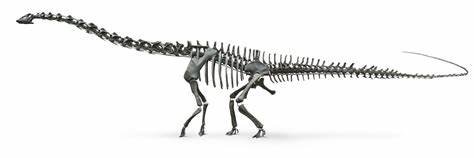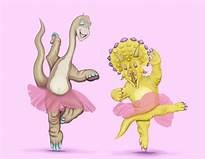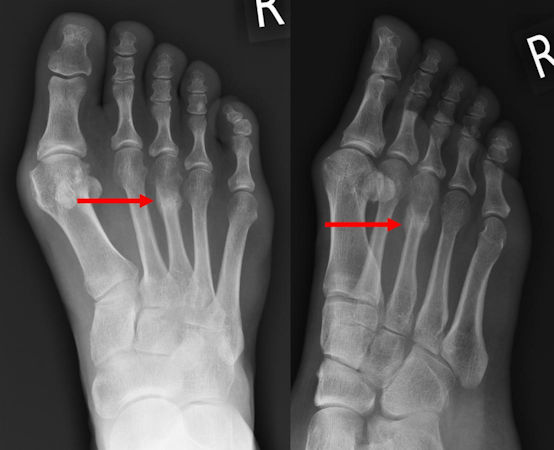Sauropods walk, skeletons talk.... Part 3 Does the tail wag the dog?
Sauropod dinosaurs perhaps represent a case of "the tail wagging the dog". The center of balance in some sauropods (diplodocids) is in front of the hind legs. The alleged tripod posture counters the body weight with the tail. Such movement requires substantial muscle strength and puts tremendous stresses on all bony attachments.

The ballet position of pointe in humans seems similar to assuming tripodal posture in sauropods. Such activities in human ballet leave their signature on the skeleton (Rothschild and Martin 1993; 2006).

The elastic modulus of the bone is repeatedly stressed, producing partial disruptions called stress fractures. Ballet dancers get them in the vertebrae, especially the transverse processes (Kadel et al 1992). If tripodal posture was practiced repeatedly, we would anticipate stress fractures in sauropod dorsal vertebrae. None have been found in examination of over 1000 sauropod dorsal vertebrae (Rothschild and Molnar 2005).

Returning to the seesaw analogy (see part 2), recall when your heavier friend released pressure on the seesaw (as a practical joke?) You landed with a thud! Imagine the thud when a 10 ton sauropod returned to the ground from a tripod posture. We should expect fossil evidence in the form of forefoot stress fractures and, again, there have been none observed (Rothschild and Molnar 2005).
Pedal (foot) stress fractures in humans are sometimes called march fractures. They are classically seen in soldiers who have marched for long distances. In dinosaurs, this could translate into migratory activity, as suggested for sauropods.
 www.davidgordonortho.co.uk
www.davidgordonortho.co.uk
However, there may be another behavioral consideration. Sauropods have traditionally been considered, or at least illustrated, as swamp dwellers. Does the presence of pedal stress fractures falsify that hypothesis? Current consensus is that such heavy animals did not frequent truly soft ground (Carpenter and Tidwell 2005). A Camarasaurus specimen recently put on exhibit at the Univrersity of Kansas shows the dangers of that activity. She died in a Jurassic river unable to pull her feet free. 
References:
Rothschild, B. M. and Martin L. D. 2006. Skeletal impact of disease. New Mexico Museum of Natural History Bulletin 18, Albuquerque.
Rothschild, B. M. and Martin L. D. 1993. Paleopathology: Disease in the Fossil Record. CRC Press: London
Kadel, N. J., Teitz, C. C. and Kronmal, R. A. 1992, Stress fractures in ballet dancers. American Journal of Sports Medicine 20:445-9.
Rothschild, B. M. and Molnar, R. E. 2005. Sauropod stress fractures as clues to activity. In Thunder-Lizards: The Sauropodomorph Dinosaurs, Tidwell, V. and Carpenter, K. (eds) Indiana University Press, Bloomington, pp 381-391.
Carpenter, K., and Tidwell, V. 2005. Reassessment of the Early Cretaceoous sauropod Astrodon johnsoni Leidy 1865 (Titanosauriformes). in Thunder Lizards: The Sauropodomorph Dinosaurs. Indiana University Press, Blooington, pp78-114.
Coming up next in Part 4: Prediction of behavior
@originalworks
The @OriginalWorks bot has determined this post by @dinodoc to be original material and upvoted it!
To call @OriginalWorks, simply reply to any post with @originalworks or !originalworks in your message!
Another great article, Doc!
Very interesting stuff. Keep them coming 😉
Well done! This post has received a 7.14 % upvote from @litasio thanks to: @steemstem-bot. Whoop!
If you would like to delegate to the @LitasIO you can do so by clicking on the following link: 10SP